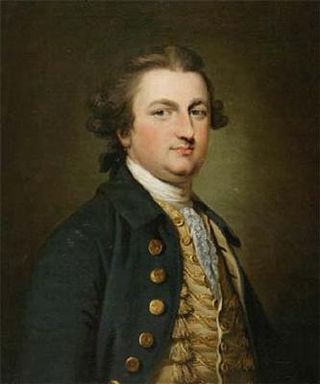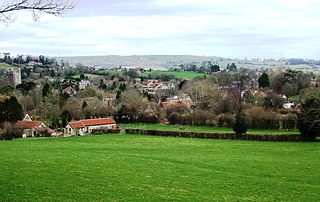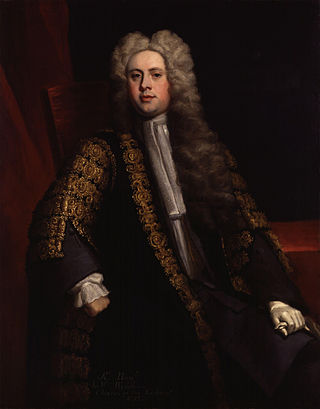
The M32 is a 4.42 miles (7.11 km) long motorway in South Gloucestershire and Bristol, England. It provides a link from the M4, a major motorway linking London and South Wales, to Bristol city centre and is maintained by National Highways, the national roads body.

Henry Somerset, 5th Duke of Beaufort was an English courtier and politician. He was the only son of Charles Noel Somerset, 4th Duke of Beaufort and Elizabeth Somerset, Duchess of Beaufort. Styled Marquess of Worcester from 1746, at his father's death on 28 October 1756, he succeeded him as 5th Duke of Beaufort, 7th Marquess of Worcester, 11th Earl of Worcester, and 13th Baron Herbert.

Elizabeth Somerset, Duchess of Beaufort was born in Stoke Gifford in Gloucestershire to John Symes Berkeley and Elizabeth Norborne. Her younger brother was Norborne, Lord Botetourt.

Chew Stoke is a small village and civil parish in the affluent Chew Valley, in Somerset, England, about 8 miles (13 km) south of Bristol and 10 miles north of Wells. It is at the northern edge of the Mendip Hills, a region designated by the United Kingdom as an Area of Outstanding Natural Beauty, and is within the Bristol/Bath green belt. The parish includes the hamlet of Breach Hill, which is approximately 2 miles (3.2 km) southwest of Chew Stoke itself.

Badminton is a village and civil parish in South Gloucestershire, England. The only settlement in the parish is Badminton village, sometimes called Great Badminton to distinguish it from the hamlet of Little Badminton, about one mile to the north in Hawkesbury parish. The large country house called Badminton House is close to the north end of the village, and its surrounding deer park lies to the north and west.

Badminton House is a large country house and Grade I Listed Building in Badminton, Gloucestershire, England, which has been the principal seat of the Dukes of Beaufort since the late 17th century. The house, which has given its name to the sport of badminton, is set among 52,000 acres of land. The gardens and park surrounding the house are listed at Grade I on the Register of Historic Parks and Gardens.

Stapleton is an area in the northeastern suburbs of the city of Bristol, England. The name is colloquially used today to describe the ribbon village along Bell Hill and Park Road in the Frome Valley. It borders Eastville to the South and Begbrook and Frenchay to the North. It comprises an eclectic mix of housing mainly from the Victorian, Edwardian, inter-war and late 20th century periods.

Glenside campus is the home of the Faculty of Health and Applied Sciences at the University of the West of England, in Bristol. It is located on Blackberry Hill in the suburb of Fishponds. Its clocktower is a prominent landmark, visible from the M32 motorway. Several of the buildings on the site are Grade II listed.

Shirehampton is a district of Bristol in England, near Avonmouth, at the northwestern edge of the city.

David Robert Somerset, 11th Duke of Beaufort GCC, known as David Somerset until 1984, was an English peer and major landowner.

Sir William Wyndham, 3rd Baronet, of Orchard Wyndham in Somerset, was an English Tory politician who sat in the House of Commons from 1710 to 1740. He served as Secretary at War in 1712 and Chancellor of the Exchequer in 1713 during the reign of the last Stuart monarch, Queen Anne (1702–1714). He was a Jacobite leader firmly opposed to the Hanoverian succession and was leader of the Tory opposition in the House of Commons during the reign of King George I (1714–1727) and during the early years of King George II (1727–1760).

Henry Hugh Arthur FitzRoy Somerset, 10th Duke of Beaufort, styled Marquess of Worcester until 1924, was a peer, landowner, society figure and a great authority in the fields of horse racing and fox-hunting. As a relative and very close friend of the Royal family, he held the office of Master of the Horse for 42 years (1936–1978), the longest to hold the position. He founded the Badminton Horse Trials and was deemed "the greatest fox-hunter of the twentieth century"; his long tenure as Master of the Beaufort Hunt led to his being universally nicknamed Master and his car bore the private numberplate MFH1. In 1980 he published the authoritative book Fox-Hunting.

The English city of Bristol has a number of parks and public open spaces.

The North Fringe of Bristol, England is a mostly developed area between the northern edge of the administrative city of Bristol and the M4 and M5 motorways. Its eastern edge is usually defined as the M32 motorway. The area falls within South Gloucestershire Council, and is the northern part of Greater Bristol.

Troy House is a Welsh historic house, on a "ducal" scale, north-east of Mitchel Troy, Monmouthshire. The original house belonged to Blanche Herbert, Lady Troy, of the Herbert family of Raglan Castle, who owned great estates in South Wales as Marquesses of Worcester and later Dukes of Beaufort. The present structure, overlooking the River Trothy was constructed from 1681 to 1684 as a wedding present for Charles Somerset by his father, Henry Somerset, 1st Duke of Beaufort. Troy House is a Grade II* listed building and its gardens and park are listed, also at Grade II*, on the Cadw/ICOMOS Register of Parks and Gardens of Special Historic Interest in Wales.

Stoke Park is a public open space of 108 hectares in Bristol, England. It occupies a prominent position on the eastern flanks of Purdown, alongside the M32 motorway, together with the landmark Dower House and Purdown transmitter. Approximately 80% of the park is within the Bristol ward of Lockleaze; the remainder is within South Gloucestershire.

Stoke Park Hospital, was a large hospital for the mental handicapped, closed circa 1997, situated on the north-east edge of Bristol, England, just within South Gloucestershire. Most patients were long-term residents, both adults and children of all ages. A school was on-site. Prior to 1950, it was known as the Stoke Park Colony, which was founded in 1909.

MetroBus is a bus rapid transit system in Bristol, England, created as a joint project between Bristol, North Somerset and South Gloucestershire councils. The first route, service m3, began operations on 29 May 2018, followed by m2 on 3 September 2018, m1 on 6 January 2019 and m4 on 22 January 2023.

John Symes Berkeley (1663–1736) of Stoke Gifford near Bristol was an English Member of Parliament.





















